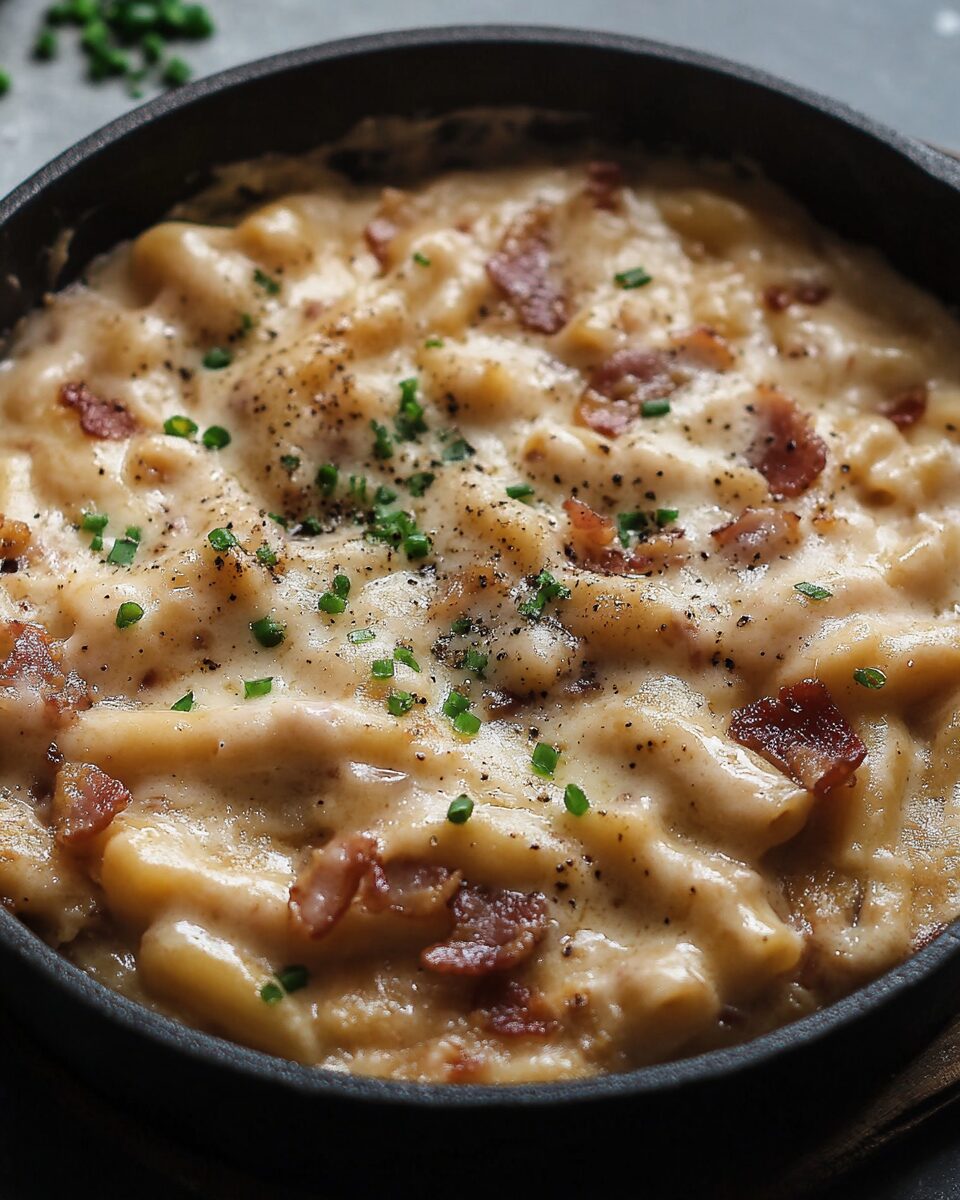This creamy, cheesy carbonara-style tteokbokki is a delightful fusion dish combining tender Korean rice cakes with a savory carbonara sauce. Perfect as a snack, appetizer, or main dish, it’s a non-spicy alternative to the traditional tteokbokki.
FULL RECIPE
Ingredients
- Korean rice cakes (tteok/dduk), fresh, refrigerated, or frozen
- 1 onion, chopped
- 2 cloves garlic, minced
- 4 strips bacon, chopped
- 2 cups whole milk (or 1/2 cup heavy cream + 1/2 cup water)
- 1/2 cup freshly grated Parmesan cheese
- 1/2 cup shredded mozzarella cheese
- Fresh parsley for garnish
- Black pepper, to taste
Directions
- Prep the rice cakes: If frozen, soak in cold water for 15-20 minutes; if refrigerated, rinse and drain; if fresh, add directly to the sauce.
- In a non-stick skillet, cook bacon until crispy.
- Add onions and garlic to the bacon and sauté until softened.
- Stir in the rice cakes and pour in the milk. Cook until rice cakes become soft and chewy.
- Add Parmesan cheese and stir until melted and combined.
- Remove from heat and mix in mozzarella cheese. Garnish with parsley and black pepper. Serve and enjoy!
Nutritional Information
- Calories: ~350 per serving
- Protein: 15g
- Carbs: 45g
- Fat: 12g
- Fiber: 2g
- Sodium: 600mg
Origins of Tteokbokki
Tteokbokki is a beloved dish in Korean cuisine, traditionally made with chewy rice cakes (tteok) in a spicy and savory sauce. Its origins date back to the Joseon Dynasty, where it was originally served as a royal dish. Over time, the dish evolved, incorporating different ingredients and flavors. The introduction of gochujang (Korean chili paste) transformed tteokbokki into a spicy street food that became widely popular. However, modern variations, like creamy carbonara tteokbokki, have added a unique twist to this classic dish.
Fusion Cuisine Trend
Fusion cuisine blends ingredients and techniques from different culinary traditions, creating innovative dishes that appeal to diverse palates. The creamy carbonara tteokbokki combines Italian carbonara sauce with the distinct Korean rice cakes, offering a savory and comforting dish that merges the rich, cheesy flavors of carbonara with the chewy texture of tteok. This fusion results in a dish that is both familiar and exciting, showcasing the versatility of tteokbokki.
Cheese’s Role in the Dish
Cheese is the cornerstone of many Italian dishes, and in this recipe, it transforms tteokbokki into a rich, indulgent meal. The combination of mozzarella and Parmesan cheeses adds creaminess and depth to the sauce. Parmesan’s nutty, salty flavor balances the creamy mozzarella, which gives the dish a melt-in-your-mouth texture. Together, the cheeses elevate the dish, making it comforting and hearty.
Bacon’s Smoky Flavor
Bacon is another key ingredient in this creamy carbonara tteokbokki. The crispy, smoky bacon adds an extra layer of flavor that complements the richness of the cheese sauce. Bacon’s salty and savory notes contrast with the subtle sweetness of the rice cakes, creating a harmonious balance of flavors. The texture of the crispy bacon also adds an enjoyable crunch, enhancing the overall eating experience.
The Importance of Rice Cakes
The rice cakes used in tteokbokki are made from glutinous rice flour, giving them a chewy and slightly sticky texture. This texture is essential to the dish, as it allows the sauce to cling to each rice cake, providing a satisfying bite. Whether fresh, refrigerated, or frozen, rice cakes are the foundation of tteokbokki, and their unique texture sets it apart from other dishes.
Adapting to Non-Spicy Tteokbokki
While traditional tteokbokki is known for its spicy kick, this creamy carbonara version provides a non-spicy alternative, appealing to those who prefer milder flavors. The creamy sauce becomes the focal point of the dish, replacing the spiciness typically associated with tteokbokki. This makes the dish accessible to a wider audience, including those who might not enjoy spicy foods.
Cooking Method: Sautéing and Simmering
The method of cooking this dish involves two primary techniques: sautéing and simmering. First, the bacon is sautéed to render its fat and achieve a crispy texture. The onions and garlic are then sautéed in the same pan, which allows the flavors to meld together. Once the rice cakes are added, the dish is simmered in milk, allowing the rice cakes to absorb the creamy sauce and soften to the perfect texture. These techniques are essential for achieving the rich, velvety sauce that defines this dish.
The Creamy Carbonara Sauce
The sauce for this dish is inspired by the classic Italian carbonara, which typically consists of eggs, cheese, and pancetta. In this variation, heavy cream or milk replaces eggs to create a smooth, rich sauce. The creamy texture enhances the dish, coating the rice cakes and providing a comforting, velvety mouthfeel. The Parmesan and mozzarella contribute not only to the flavor but also to the sauce’s creaminess.
The Role of Garlic and Onion
Garlic and onion are essential in building the base flavor of this dish. Garlic adds a pungent, aromatic quality that infuses the sauce, while onion brings a natural sweetness and depth to the overall flavor profile. Both ingredients are sautéed to soften and mellow their flavors, ensuring that they don’t overpower the dish but instead complement the richness of the creamy sauce.
Garnishing with Fresh Herbs
Garnishing is an important step in any dish, as it not only adds visual appeal but also enhances the flavor. In this recipe, fresh parsley is used as a garnish. The bright, herbal notes of the parsley provide a refreshing contrast to the rich and creamy sauce, adding a touch of freshness to each bite. The green color also makes the dish look more vibrant and appetizing.
Perfect Pairing Suggestions
Creamy carbonara tteokbokki pairs well with a variety of side dishes. Consider serving it with a simple green salad to balance the richness of the dish. The crisp, fresh flavors of the salad will complement the creamy sauce. Alternatively, serving this dish with kimchi adds a touch of tanginess and spice, which contrasts beautifully with the creamy tteokbokki. A cold, refreshing drink, such as iced tea or lemonade, would also be a great complement.
Meal Planning and Leftovers
This dish is perfect for meal planning, as it can be made in large batches and stored for later. If you have leftovers, simply store them in an airtight container in the refrigerator. The dish can be reheated in the microwave or on the stovetop, though the rice cakes may become slightly softer after being stored. However, the flavors will continue to develop and remain delicious even the next day.
Customizing the Recipe
One of the great things about this recipe is its versatility. While the traditional recipe calls for bacon, you can substitute it with other proteins like sausage, ham, or even mushrooms for a vegetarian option. If you prefer a spicier version, you can add a bit of gochujang or chili flakes to the sauce. This adaptability makes it easy to tailor the dish to your personal preferences.
A Comforting Weeknight Meal
Creamy carbonara tteokbokki makes for a fantastic weeknight meal. It’s relatively easy to prepare and can be made in less than 30 minutes. The creamy sauce and chewy rice cakes are filling and satisfying, ensuring that you and your family will be content after a busy day. Whether you’re cooking for yourself or a crowd, this dish offers both convenience and comfort.
Tteokbokki in Korean Culture
Tteokbokki is a staple in Korean street food culture. It is often served in small shops or food carts, where people can enjoy it as a quick snack or a light meal. The dish is beloved by Koreans of all ages and is often enjoyed in the evenings as a warm, comforting treat. This fusion version takes the essence of traditional tteokbokki and transforms it into something new and exciting.
The Appeal of Carbonara
Carbonara is a popular Italian pasta dish that is loved for its simplicity and richness. The dish is traditionally made with eggs, cheese, pancetta, and pasta, creating a creamy sauce without the use of heavy cream. The rich, savory flavor profile of carbonara is what makes it so comforting. By incorporating these flavors into tteokbokki, the dish becomes even more indulgent, with the addition of creamy sauce and bacon.
Tteokbokki as Comfort Food
Tteokbokki, in its various forms, is considered a comfort food in Korea. The soft, chewy rice cakes combined with a rich sauce make for a satisfying and filling meal. Whether served as a quick snack or a more elaborate dish like this creamy carbonara version, tteokbokki provides a sense of warmth and contentment. The creamy carbonara tteokbokki, in particular, is perfect for those seeking a heartwarming, indulgent dish.
Balancing Flavor and Texture
One of the key elements of this dish is the balance between flavors and textures. The creamy sauce contrasts beautifully with the chewy rice cakes, creating a delightful textural experience. The crispy bacon adds crunch, while the cheeses provide a smooth, velvety consistency. Each component works together to create a harmonious and satisfying dish.
Perfect for Special Occasions
While creamy carbonara tteokbokki is an ideal weeknight meal, it also makes an excellent dish for special occasions. Its unique fusion of Italian and Korean flavors makes it a conversation starter at dinner parties or gatherings. The richness of the dish ensures that it will be a hit with guests, leaving them impressed and satisfied.
Conclusion
Creamy carbonara tteokbokki with bacon is a delicious fusion of two beloved cuisines. The combination of chewy rice cakes, rich carbonara sauce, and crispy bacon creates a dish that is both comforting and indulgent. Whether you’re new to tteokbokki or a longtime fan, this version offers a unique twist that is sure to satisfy. With its balance of flavors and textures, it’s a perfect dish for any occasion, from a casual weeknight meal to a festive gathering.






